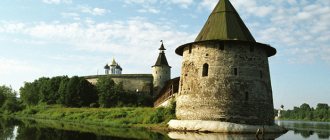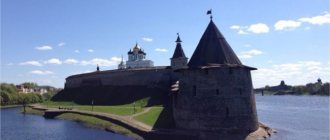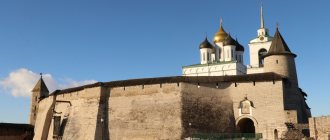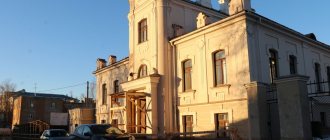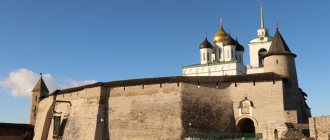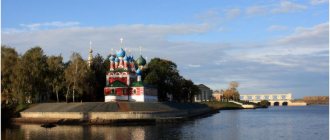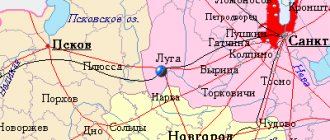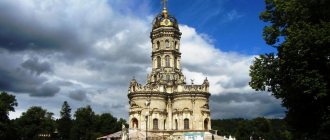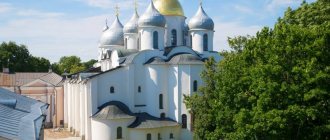Pskov is one of the oldest cities in Russia. Most often he is associated with the white stone Kremlin, Princess Olga, “a thousand churches” and the famous division. What else is the city famous for on the banks of the Velikaya River? The Pskov Information Agency has prepared a selection of the most amazing and unexpected stories about Pskov that happened over its centuries-old history. So, what every Pskovite knows and what he will be happy to tell tourists about - a note for those who are planning a trip to this city.
Your own mint
Pskov is such a unique Russian city that it even had its own money. The Pskov Mint (money) court issued its own coins from 1425 to 1510, and then, until its closure in 1632, minted money for the entire Russian state, together with the Moscow and Novgorod courts.
The coins of Pskov, like the coins of Novgorod, were divided into “dengi” (“Pskovka”) and “chetverettsy”, which formed part of them. On Pskov money, on the obverse side, an image of Prince Dovmont , who ruled Pskov from 1266 to 1299, was minted, wearing a crown and holding a sword. On the reverse side one could see the inscription “Pskov denga”, or a four-legged animal, presumably a leopard, turned to the right or left, framed by a similar inscription.
The design of Pskov coins was different from those minted in other cities - the “Pskov coins” were clearer, more standardized, which is typical of the European-Western type.
The minting of coins indicates the maturity of the subject in the international arena. Pskov conducted active trade with the cities of the Hanseatic League, as evidenced by archaeological finds, including from the Mstislavsky excavation site, where Western European lead trade seals were found.
Before the appearance of the mint in Pskov, foreign coins were used, and in some cases, lead seals with a princely sign and an image of a saint were used to seal documents for small transactions or orders. Because they were no longer needed, they were sometimes thrown away, and local residents exchanged small lead pieces for bread, which clearly was not worth a whole silver coin. Also, money was replaced by wiped squirrel skins.
In the 16th century, the population of the city then exceeded 30 thousand people, most of whom were artisans and traders. In the city there were many blacksmiths, masons, tanners, potters, jewelers and merchants who traded with Russian cities, the Baltic states and Lithuania. Pskov residents sold flax, leather, fish, honey, wax, furs, and bought salt, cloth, iron, and metal products.
Some more interesting facts about Pskov
- In the Pskov region there is Dovmontov city , which is a ruined stone settlement and is proudly referred to by local residents as “Pskov Pompeii” .
- This settlement is the site of Russia's largest honey festival , which ends every year with the eating of a 100-kilogram gingerbread.
- The Pogankin Chambers of Pskov received this name not because of the quality or beauty of their construction, but because of the superstition of the locals, because they were founded by the descendant of the person who found the treasure (which was considered not good, i.e. “filthy”).
- Before the founding of St. Petersburg, this city was the largest in Rus' and one of the largest in all of Western Europe.
- From the 13th century to the 18th century, this settlement took part in as many as 130 wars , which the locals have their own saying about.
- The region of the same name borders on three foreign neighbors: Estonia , Belarus and Latvia , which is an absolute record among all regions of Russia.
- Unlike the rest of Russia, this settlement has preserved many Orthodox churches from the 12th and 15th centuries , while in the rest of Russia they were (mostly) burned by the Mongols.
- The Pskov Kremlin is one of the top 10 tourist attractions in Russia (according to the Russia-10 competition of 2013).
- Locals call their Kremlin “Krom” .
- Pskov was not taken even by the army of King Stefan Batory , which numbered 50,000 Poles .
- All conscript princes of Pskov were given the sword of St. Dovmont-Timothy , which is now kept in the Pskov Museum-Reserve.
- This region is the birthplace of the famous princess Olga , who was married to Igor Rurikovich according to the command of the Prophetic Oleg.
- Since 2009, Pskov has been officially considered the “city of military glory” .
- The area of the city is just a little short of the treasured and beautiful 100 square kilometers: now this figure is 95.6 square kilometers .
Anathema of Pskov
The people of Pskov were also famous for their willingness to help their neighbors, for which they once paid. In 1329, the city was anathematized, all churches in Pskov were closed. So the Moscow prince Ivan Kalita and Metropolitan Theognost wanted to humble the believing Pskovites who accepted the disgraced prince Alexander of Tver.
In 1327, an uprising against the Tatars began in Tver; Uzbek Khan became angry with the prince, and he was forced to seek refuge. The people of Pskov accepted Alexander Tverskoy, which may be connected not only with their personal qualities, but also with the promise given to Alexander Nevsky in 1244: Pskov was supposed to help the descendants of the prince, who were Alexander Tverskoy, in difficult times.
The Tver prince ruled in Pskov for about 10 years. The townspeople loved him, but they did not have the strength to fight their aggressive neighbors. The rebellious Pskovites increased discontent in the Horde, which forced the Metropolitan to take extreme measures and excommunicate the entire city from the church. The Russian princes persuaded Alexander to go to the Horde so that there would be no new Tatar invasion of Rus', but the Pskovites did not let their prince in: “Don’t go, sir, to the Horde; no matter what happens to you, we will die, sir, with you in the same place.” However, Alexander said to the Pskovites: “My brothers and my friends, there will be no curse on you for my sake; I’m leaving your city and I’m taking off the kiss of the cross, just kiss the cross so that you won’t betray my princess.”
The Pskovites kissed the cross and released Alexander to Lithuania, his wife remained in Pskov. According to the chroniclers, the townspeople grieved for a long time: “there was torment and sadness in Pskov and there was a lot of rumors about Prince Alexander, who with his kindness and love came to the hearts of the Pskovites.” After this, Kalita made peace with Pskov, and Metropolitan Theognost and the Novgorod ruler blessed the mayor and the entire city.
After some time, Alexander returned to reign in Pskov. During the period of disagreements with the Moscow prince, the Novgorodians turned to Alexander for help, and during the truce with Kalita they plotted against Pskov. As a result of another quarrel with Moscow in 1337, they did not find support among the Pskovites, and Novgorod Archbishop Vasily also declared a curse on the city.
A year later, Uzbek pardoned Alexander and returned his Tver reign. Pskov continued to exist as a republic (1200 to 1510), the princes were replaced one after another, but internal power, in fact, was concentrated in the hands of the veche, mayors, centurions and intra-city structures.
Russian Paris
In 1510, Pskov was annexed to Muscovite Rus' and remained a major trade and craft center of the Russian state. The size of the city impressed even those who tried to storm it. “We admire Pskov. Lord, what a big city! Exactly Paris! God help us. To cope with it... The city is extremely large, the likes of which is not found in all of Poland, it is all surrounded by a wall, behind it there are churches, all made of stone; priest Piotrovsky , a participant in the siege of Pskov in 1581, personal secretary of Stefan Batory .
We failed. The siege of Pskov lasted six months, the Poles bombarded the walls, stormed Pskov, Batory tried to seduce the townspeople with promises of returning them independence, ancient customs and freedom. But the Pskovites did not surrender the city, although there were half as many of them as the enemies. The general assault did not produce results, as did the digging under the fortress walls, and the troops of Stefan Batory were forced to retreat. The heroic defense of Pskov thwarted the aggressive plans of the Polish king, and Russia made peace on terms favorable to it.
Other foreigners also spoke about the merits of the Pskov fortress, the splendor of the buildings and the crowded population of Pskov. The city was often compared in size to Western European cities. Back in the 13th century, the author of a German chronicle said about Pskov: “This city is so vast that its circumference embraces the space of many cities, and in Germany there is no city equal to Pskov.”
The most protected city
Pskov owes its legendary inaccessibility to its fortress walls . In this populated city there were as many as 5 of them, and not just fortresses, but protective rings around the center - the main square. 39 defensive support towers on the walls (the highest of which remain Pokrovskaya and Gremyachaya to this day), and the total length of the walls extended over more than 9 kilometers .
King fish
In the 16th century, Pskov was known not only for its stunning views, but also as an economically developed city. The Pskov market was built up with two thousand shops, barns, and sheds. Large fairs were held here in January and May. During the winter season, in particular, large quantities of timber and dry smelt were sold.
The latter have gained popularity throughout Russia. Smelt is a small fish from the freshwater smelt family; it was caught commercially in the Pskov-Peipus reservoir, then salted and dried. There was a lot of smelt, it reproduced well, it was convenient to catch, store and transport it over long distances. In this regard, the product has become one of the main ones on the Pskov market. In addition, smelt was a cheap and at the same time tasty fish, so it was present on the tables of all townspeople, regardless of class. They made a stew from it, the smelt was fried, stewed, and dried.
The small fish greatly helped out the inhabitants of the islands of Lake Pskov in the post-war period. The islanders took it to Leningrad for sale, and that’s all they lived for. For many Soviet people, the best present from Pskov was a large box of dried smelt - original, inexpensive and tasty.
In recent decades, there has been less smelt in Pskov reservoirs, its cost has increased, but an established brand can still be found on the shelves. And if you find an old-timer, you can find out the original recipe for smelt in Talab style.
Pskov crocodiles
Ancient chronicles cite one amazing incident that occurred in 1582: crocodiles came to the shore of the Velikaya River in Pskov and sowed panic among the townspeople.
The story, of course, is out of the ordinary. It’s hard to believe that reptiles that prefer a tropical climate could survive the harsh Pskov winters. Historians eventually agreed that crocodiles were brought to Pskov by merchants who had visited hot countries. There is information that in 1559 the Smolensk merchant Vasily Pozdnyakov went to Cairo, and 23 years later, when “corcodiles” were seen in the Velikaya River, the palace clerk Trifon Korobeinikov . The notes of the Austrian diplomat Herberstein also mention that large lizards are kept in captivity in Lithuania, which according to the description resemble either monitor lizards or crocodiles. And the path to Lithuania just passed through the Pskov lands.
Probably, during the movement of the trade caravan through Pskov, something went wrong, and the crocodiles, which were taken to exhibitions and menageries, ended up in the river. Either they ran away due to an oversight, or someone specially released them so that the Pskovites could look at the curiosity.
Reptiles kept the residents of Pskov and surrounding villages in fear all summer. In the warm season, crocodiles felt great, hunted fish and animals, but with the onset of cold weather they died.
Fact 3. The most ancient Christian temple
Everyone still knows from school that the Kiev prince Vladimir converted to Christianity and baptized Rus' in 998. Vladimir had a grandmother, originally from Pskov, Grand Duchess Olga. She converted to Christianity in Constantinople, after which she ordered the construction of the Trinity Church in Pskov. Thus, the first Christian temple appeared in 957, even before Christianity became the state religion.
At the moment, the Trinity Church is the oldest, remaining from the times of Kievan Rus.
Rattling Tower
The Gremyachaya Tower on the banks of the Pskov River is shrouded in many legends. One of them says that under the building there is a crypt with treasures, where a girl in a wedding dress sleeps soundly. Anyone who can wake up the local sleeping beauty will receive her entire dowry - barrels of gold and other jewelry, which, according to some, sometimes rattle - hence the name of the tower.
There are only a couple of “buts”: only a person with a pure soul and thoughts can bring the enchanted girl back to life. In addition, you will have to sit for 12 days and nights near her coffin (which still needs to be found). They say that many tried to fulfill all the vows, but no one could stand the test - everyone died.
Another story behind the name seems a little more plausible. Pskov was captured by the Teutonic knights, the young prince tried to start an uprising, but he was imprisoned in the Gremyachaya Tower and then killed. The townspeople still tried to defend Pskov, and in the midst of the battle thunder struck, lightning flashed and a huge shadow of the deceased prince appeared on the walls of the tower. The knights wavered, and victory was for the Pskovites.
Some tell the story of a Pskov craftsman who, during a feast on the day of St. John the Evangelist, crossed himself and immediately found himself on the roof of the structure, which was later called the Gremyachaya Tower. There is also a version that a river flowing nearby, known for its noisy rapids, could have a similar name.
Today it is a very picturesque place that continues to attract lovers of mysticism. No, no, and someone will try to find countless treasures, see the prince or take possession of the beauty. So far no one has succeeded.
The merchant is filthy
Pskov residents talk about one poor man who was engaged in making barrels and suddenly became rich. According to one version, in the corner of his modest shack he managed to find a treasure trove with countless treasures. True, in Rus' they did not approve of this method of obtaining wealth and called it filthy. So the name Pogankin stuck to the man, and his descendants became merchants. One of them, Sergei Pogankin , built chambers in Pskov in the 17th century; they began to be called Pogankin chambers.
There is another legend about the origin of the surname. One day, Tsar Ivan the Terrible came to Pskov, plundered it along with his army and demanded more money from the merchants. Then one of them asked how long the sovereign needed to calm down. The Terrible became angry and exclaimed: “Oh, you filthy one! Are you really so rich that you can give as much as I want?!” The merchant, understandably, was frightened and ran away, but the royal servants found him and brought him to bow to Ivan the Terrible. For some reason, the impudent Pskovite remained alive, but from then on they began to call him Pogankin.
The third (there are about five in total) Pskov legend says that a certain rich merchant did business with foreigners, who in those days were called “bastards”. So the merchant was nicknamed Pogankin.
Today, in the stone chambers of the merchant Pogankin, there is a museum with ancient utensils and items from treasures found in the city and its environs.
Holy Fool - Defender of Pskov
Another amazing story that connects Pskov with Ivan the Terrible occurred in January 1570. Then the tsar, following a false slander, carried out a massacre in Veliky Novgorod and decided, together with his guardsmen, to tame the freedom-loving Pskovites. On the approach to the city with bread and salt, he was met by townspeople numb with horror. Nikolka Salos rode ahead of everyone on a stick and declared to the king: “Ivanushka! Ivanushka! Eat better bread and salt, not Christian blood!” Ivan the Terrible became furious and ordered to seize the insolent man, but he suddenly disappeared. The shocked Tsar spared the people of Pskov and proceeded to the city, to the Trinity Cathedral.
After the service, he found Nikolka in his cramped cell. The holy fool invited Grozny to treat himself to a piece of raw meat, and after the tsar refused, citing fasting, the blessed one said: “You drink human blood!”
The meeting with Nikola Salos influenced Ivan the Terrible so much that he refused to ravage Pskov and left it without shedding a drop of blood. After the death of the holy fool, grateful townspeople buried him in the basement of the Trinity Cathedral and for a long time called him the main defender of Pskov.
The history of Nikola Salos is described in the chronicles stored in the Svyatogorsk Monastery; it was used by Alexander Pushkin when writing the tragedy “Boris Godunov”.
Pskov – the birthplace of people of art and science
Many famous people and personalities came from here. Thus, the most famous are Boris Troyanovsky (musician), Kaverin Veniamin (writer), Zinovy Gerdt (actor), Oksana Fedorova (TV presenter), Oleg Lavrentyev (physicist).
In the area of this settlement there are also Pushgory - Pushkinskiye Gory, the birthplace of the family of A.S. Pushkin. There, in the complex of the Svyatogorsk Holy Dormition Monastery, is the poet’s grave along with his burial place.
Peter the Great and the Skobari
Pskov attracted the attention of many royal persons, not only Ivan the Terrible. Peter I came to the city more than once , and he nicknamed the Pskov people the skobarians. One of the legends says that before the battle with the Swedes, the king visited the city forge and tried to unbend a horseshoe made by local craftsmen. But all the attempts of the sovereign, who had remarkable strength, were unsuccessful. Then Peter I exclaimed: “These are skobari!”
There is a version that after this event a special imperial decree was issued, according to which the Pskovites were obliged to produce staples for the young Russian fleet. Pskov at one time was considered the blacksmith capital of Russia - almost every Pskov family had a blacksmith, and the city supplied the entire district with hardware.
It is interesting that the word “skobar” is not in the dictionaries of the Old Russian and Old Church Slavonic languages. But the words “skopskaya” and “skobskaya” are found in ancient documents. Some see a contemptuous and derogatory connotation in this term, since sometimes ill-mannered provincials, who are characterized by inhospitability, severity and greed, were called skobers.
But the majority of residents of Pskov and the region still call themselves hardware workers, and do so with special pride; the blacksmith yard continues to operate in the city. In memory of their famous predecessors, Pskov residents celebrate the Day of the Blacksmith, and in 2014 a monument to the blacksmith was opened in the Children's Park. “Skobar” became an unofficial symbol of the city and acquired signs: they say that if you rub a horseshoe, you will be happy and good luck.b
It’s not Pskovites who live in Pskov
Oddly enough, the residents of this area are not called Pskovites or Pskovites at all. They proudly bear another name - skobari . Alas, the meaning of this word has long been lost; it is only known that its philological origins go deep into Russian history. The most common versions are that staplers were either blacksmiths who forged iron staples for locals, or misers and misers known for their greed.
Carrier from Vybut
One of the most important personalities of Pskov is the Holy Equal-to-the-Apostles Princess Olga. In Russian chronicles, Olga and Pskov were first mentioned in 903. In The Tale of Bygone Years, the monk of the Kiev-Pechersk Monastery Nestor wrote that Prince Igor was brought his wife Olga from Pskov.
Pskov legend and the lives of saints say that Olga was a carrier from Vybut (12 km from Pskov), where Prince Igor met her during a hunt. While crossing the Velikaya River by boat, he fell in love with a beautiful girl who amazed the prince with her smart speeches, modesty and beauty. After this meeting, Igor sent matchmakers for her and took Olga as his wife.
Later, having become a Christian, the Grand Duchess visited her native land. One day she stopped on the left bank of the Great River and saw three rays of sunshine that broke through the clouds and pointed to a high, deserted cape overgrown with forest on the opposite bank. Saint Olga predicted that “in this place there will be a temple of the Most Holy Trinity and the city will be great and glorious.” Afterwards, she sent people who built Pleskov City and erected the first Christian church in it at her expense in the name of the Holy Trinity. Now the Trinity Cathedral stands on this site.
The people of Pskov honor the outstanding countrywoman and consider her their heavenly patroness. The city has an embankment and a bridge named after the princess, the Olga Chapel, and two monuments to Olga. In the Vybuty churchyard, the Church of Elijah the Prophet (XV century), a memorial forged cross installed on a pyramid of stones on the site of the Olginsky chapel (late 19th century) and the Olginsky worship stone (exploded) have been preserved.
Sometimes local residents also point out unofficial memorable places: Holgin Perevoz, Holgin Bridge, Olgin Gate;
Olga Kresty village. And Nestor the chronicler wrote that in his time the sleigh of Princess Olga was kept in the Trinity Cathedral of Pskov. Moreover, the Pskov airport “Crosses” was named after Princess Olga as part of a large-scale project to assign the names of outstanding compatriots to the main airports of the country “Great Names of Russia”. Ulyana Lovygina
Pskov on the map. Map of Pskov in detail with streets, houses and districts
The page shows an interactive map of the city of Pskov with streets and houses. Pskov is an ancient city with a rich cultural heritage and magnificent architectural monuments. To zoom the geographic map, use the (+) and (-) buttons on the left side. On the map of the city of Pskov you can see metro stations, shops, pharmacies, gas stations, routes.
Territorial structure on the map
The city of Pskov is the administrative center of the municipal formation "City District Pskov City"
Pskov is considered one of the oldest and most beautiful cities in Russia. Using a satellite map of Pskov, you can study the geographical location of the city. It is located on the coast of the Velikaya River. The Pskova River flows nearby, which connects at the city’s location with the Velikaya River.
The map can be a reliable assistant on any journey. It allows you to familiarize yourself with the city's layout in advance and find all the necessary addresses. This feature saves a lot of time.
Pskov is considered the most important center of the tourism industry. All excursion sites and hotel enterprises can be found using a detailed map of Pskov. On the territory of the city there are many ancient buildings that are monuments of ancient Russian architecture.
Map of Pskov with streets
The city has a developed transport infrastructure. Pskov also has the status of an important transport point.
A map of Pskov by district will allow you to find the following areas of the city:
- On the right bank of the Pskovaya River is the Zapskovye district. It belongs to the historical part of the city. The area itself is divided into several smaller microdistricts.
- In the Central district of the city, buildings of Soviet construction predominate. One of the prominent streets of the city is Oktyabrsky Avenue. With a map of Pskov with streets in good quality, you can find the bus station and railway station, which are located in this part of the city. Many hotels are also concentrated in this part of the city. On Nekrasova Street you can find the city's administrative building, the Philharmonic and museums.
- The Zavelichye district is located on the other coast of the Velikaya River. It belongs to the suburban area. On its territory you can find the central library and hospitals using a map of Pskov with streets and houses. An interesting little town for children's games was built on Yubileinaya Street. Multi-storey buildings are located on Riga Avenue. This area also includes some village neighborhoods.
- Many private houses can be found in the next district of Pskov - Zavokzalie. One of its microdistricts is Lopatino.
Map of Pskov with houses
Pskov is an ancient city with numerous cultural and historical monuments. It is included in many excursion routes along the Golden Ring of Russia. Yandex maps of Pskov will help you plan a walk around the city. It is worth visiting notable places in Pskov:
- The ancient temples of the city are of great historical value. They are made in the Old Russian style, which is unlike the styles of other buildings of that time. The city has preserved buildings from the 12th to 15th centuries. The main cathedral of the city is considered to be the Trinity Cathedral.
- The Kremlin is considered the most valuable attraction of the city. It was created before the 10th century. The walls and towers that still stand today date back to the 14th century.
- A map of Pskov with house numbers will allow you to find the temple on Vasilievskaya Hill. It was built in the 16th century.
- Next to the Trinity Cathedral is the ancient Vechevaya Square.
- Fans of historical events are recommended to visit the museum reserve with an art gallery. The city also has a planetarium, a craft museum and a two captains museum.
- It is worth visiting the ancient building of the Order Chambers, in which, after restoration, a museum was formed. On the second floor of the building, the interior of bygone times has been completely restored.
- The Mirozhsky Monastery is considered a unique attraction. Its main decoration is the ancient frescoes, which were created back in pre-Mongol times.
- Using the Pskov routes on the map, you can get to the outer city wall. This is an ancient building, in which the ancient fortress tower is still preserved. Its height is 90 meters.
- In the city you can see ancient chambers that were created in the 17th century from stone. In ancient times, buildings were painted white and decorated with carved porches.
A map of Pskov will help you study the location of streets and the exact location of excursion sites.
